Fish is one of the best survival foods you will ever find. It is packed with protein, full of fatty oils, and can be found in almost any body of water. However, in a survival situation you rarely have a rod and reel with you. So now what?
The rod and reel is a much more modern invention and is designed to catch one fish at a time while targeting a specific species.
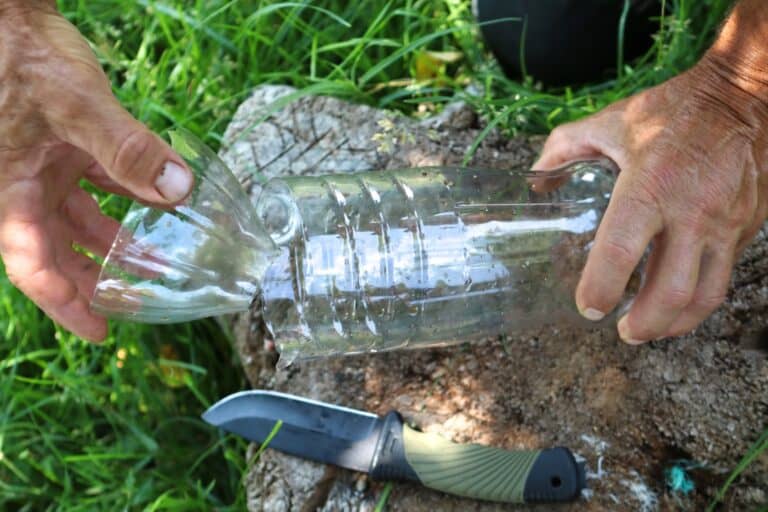
When you are trying to survive you will likely not be that selective. The goal is to gather as many fish as possible no matter what the species.
Primitive fish traps are the best way to do this. These traps use natural and found materials to catch fish and hold them until you can check your trap. They are all fairly simply, but some require more time for construction than others.
#1. Bottle Fish Trap
This is definitely the easiest trap to build. Any plastic bottle will work well for this, but a 2 liter bottle works best.
Remove the label from your bottle, and cut the top off just below the bend:
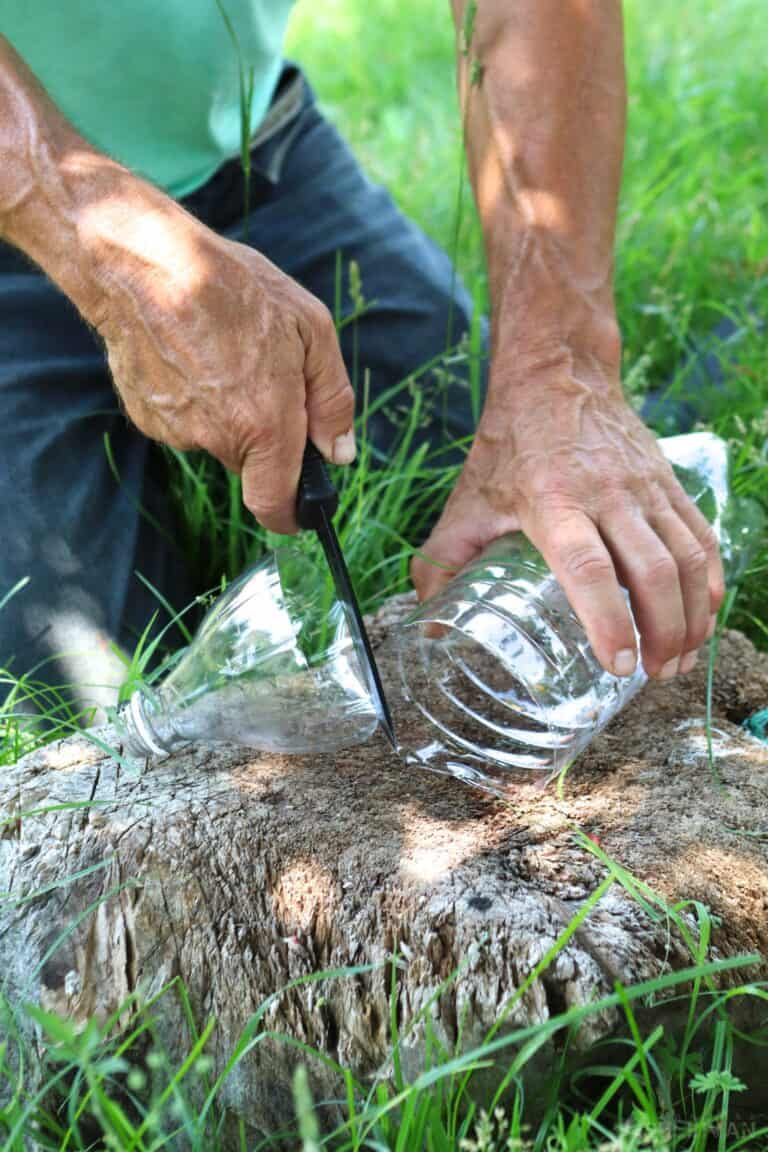
Next, you can cut the mouth of the bottle to be a bit larger if you want to attract larger fish:
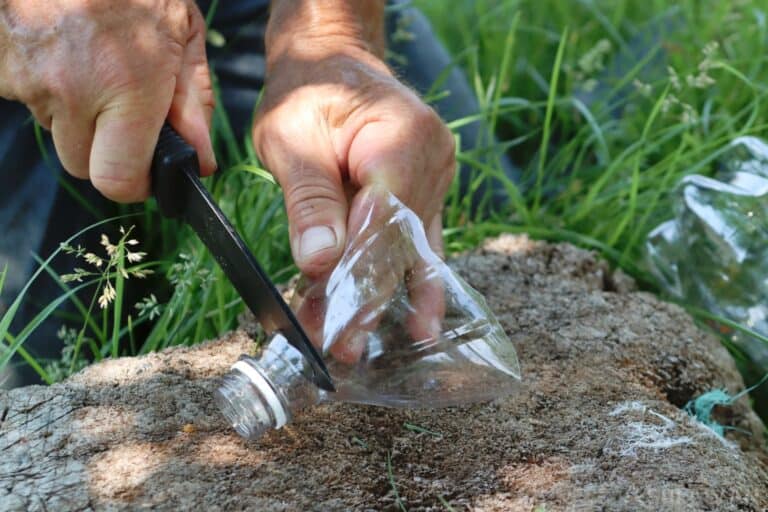
Reverse the top of the bottle to face in and push it back into the base:

Punch small holes around the lip:
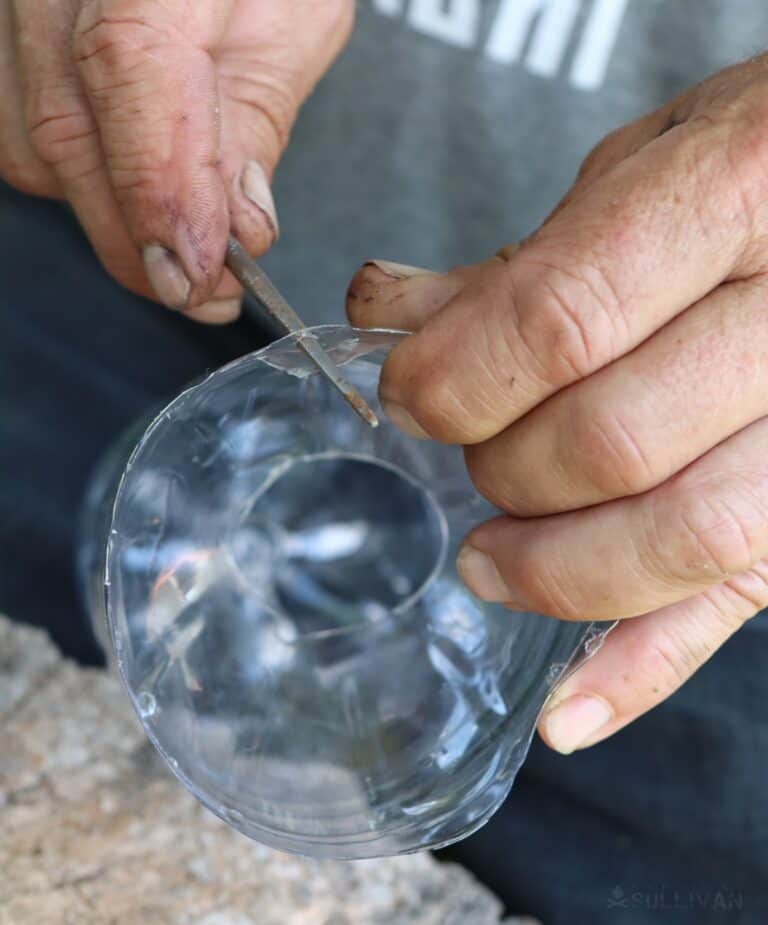
Then, use cordage to secure the top in place in three or four spots:
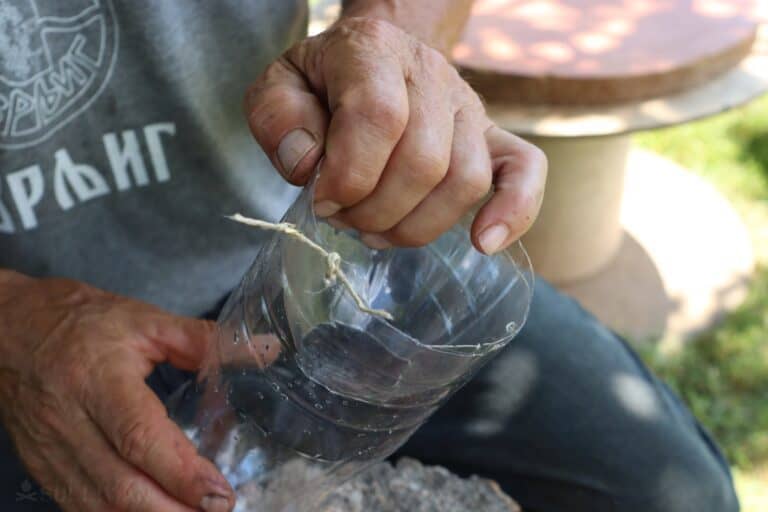
To weigh it down you can put a few rocks in the trap or attach cordage and tie it to a rock on the bottom:
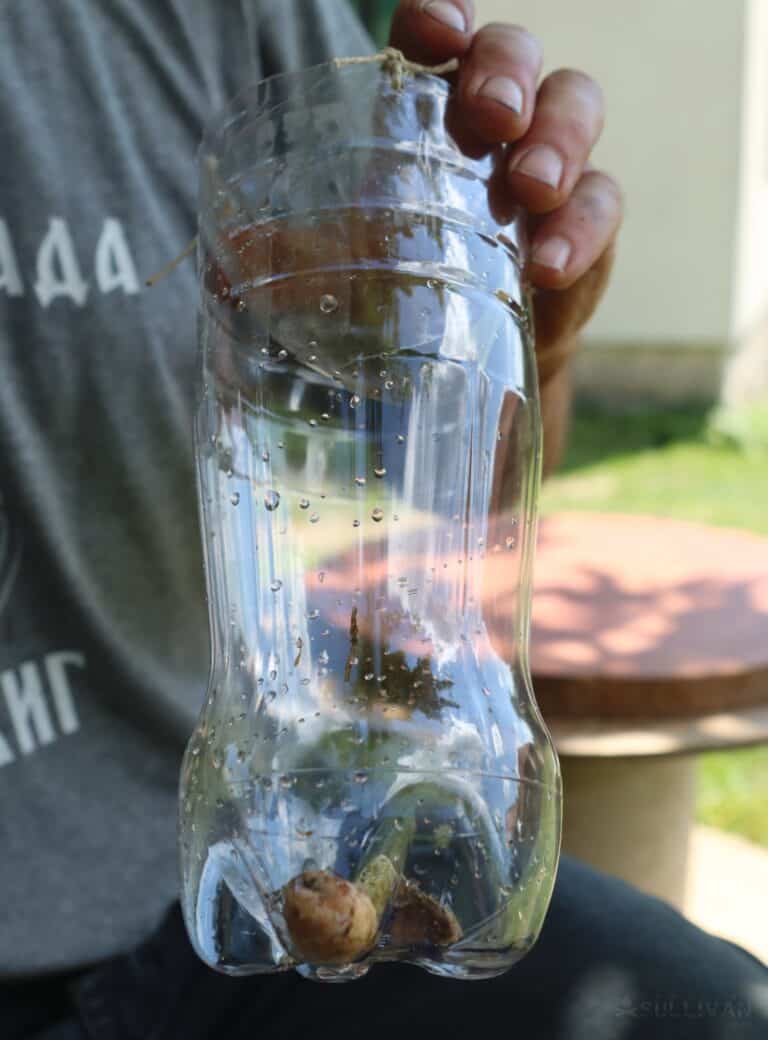
This trap works the same way most fish traps work. The fish swim in the mouth, get confused, and cannot figure out how to escape. You can add bait to the trap or set it out and hope to get lucky.
#2. Heart Shaped Fish Trap
This trap uses the same principle, but on a much larger scale. In a shallow pool use rocks or stakes to build walls in the shape of a heart with the point facing downstream.
Make sure your wall is tight enough that there are no openings that will allow your target fish to escape. Next make a small opening in the cleavage of the heart. It should only be large enough to let one fish enter at a time.
You can either bait the interior area or scare the fish into your trap. This trap is large enough that a few large rocks thrown into the water at the right spot could direct them towards the entrance.
To be sure they will not escape, you can add a second heart just downstream from the first so they have to escape two traps to get free. In this design, one heart spills into the other.
With a trap this large you have to find a way to remove the fish from the trap. Chances are they will not just let you grab them.
For this you can beat the surface of the water with a flat stick. The impact will send a shockwave that will stun the fish so you can grab them. You can also spear them, but this takes much more time and skill.
Finally, you can gather some leafy branches and throw them on top of the fish. This will hold it still while you scoop up the branches and throw them on shore along with the fish.
#3. The Fish Weir
This trap is designed for a narrow section of running or tidal water. The idea is that either the tide or current will direct the fish into the trap.
In a narrow channel you will first build a wall straight across using stakes or rocks. It should be thin enough to allow water to freely pass through without allowing fish to pass through.
Next, you can add your funnel. This could be upstream or downstream depending on the type of fish in the area. Simply build walls in the shape of a ‘V’ with the point facing the first wall. Then make a small opening at the point allowing one fish at a time to swim through.
When finished the tide or current should pass through with little resistance so the fish are swept right into the trap. As with the previous trap, you will have to devise a way to get the fish onto shore. You can also bait this trap or let the current do the work.
#4. The Basket Trap
This is by far the most difficult trap to construct, but some survivalists have gotten to where they can throw one together in no time at all. The idea is the same as the bottle trap, but this is larger and made with natural materials. Reeds or small branches work well for this.
First you will need to make a basket with a point at one end and an opening at the other. The opening should be at least 10 inches in diameter. The easiest way to construct this is to use longer material to run the full length of the basket.
Then use cordage, vines, or roots to close the pointed end and to hold together the open end. As long as the fish cannot get through any side openings, the basket will work.
Next you need to construct the funnel. This is simply a cone shape with an opening at the point. Make sure the opening is large enough for your fish to swim through. Again, use longer pieces to run the length of the cone and use cordage to secure the ends.
The cone should be half as long as your basket at the most. There needs to be room for fish to swim through the opening of the cone and get stuck in the basket.
Now it is time to put the two pieces together. Just like with the bottle trap, put the funnel into the basket with the point facing in.
Then use cordage, vines, or roots to secure the two together. You can add weight to the trap to keep it on the bottom, or you can use cordage to tie it to a rock on the bottom to keep it in place.
This trap can be baited or just left out, but baiting works best. Also, because this trap has an unnatural appearance it works best in areas that are reedy or have a large amount of debris. This helps them blend in so the fish are comfortable enough to go exploring.
#5. Basket Crayfish Trap
One of the most prevalent fresh water animals is the crayfish. They can be found in several places around the world, but this trap also works on fresh water prawns or anything similar.
The idea is that they crawl up a platform looking for bait and then fall into the chamber below. These animals cannot get the height they need to get back out.
First, find a handful of sticks about as thick as a finger and about two feet long. Shove them into the ground at one point and then spread the points at the other end so they form a circle about 18 inches in diameter.
Find some cordage, vines, or roots and start weaving it in between the support sticks starting at the bottom and working your way up to the top.
Once you have formed your basket, get several more sticks about as thick as a finger and 18 inches long. Split them lengthwise and then sharpen one end.
Lay your basket on its side and shove your first stick through the right side at the opening and then across through the left side. You want the flat side to face up. Then insert the next stick just inside the first one and slightly higher.
As you insert the rest of the sticks, this should create a ramp that goes ¾ of the way into your basket leaving a small opening at the top.
This trap will need to be placed in a shallow, still pool where you might find these animals. It should be completely submerged and set on its side with rocks holding it on the bottom.
Crayfish are carnivores, so you will need some meat for bait. Beef jerky works well, and I often have some with me when in the wilderness.
As you can see, a fancy ultralight rod and reel are not needed for survival fishing. In fact, one could argue that a rod and reel would prevent you from collecting the most meat possible. In addition, a rod a reel are typically not practical to carry with you.
Even if I know I will need to find food in the wilderness, I rarely want to carry around a rod several feet long with line that can tangle on every branch I pass. I would much rather build a trap with found materials and watch the fish pile up.
Give it a try the next time you find yourself next to a creek or pond.
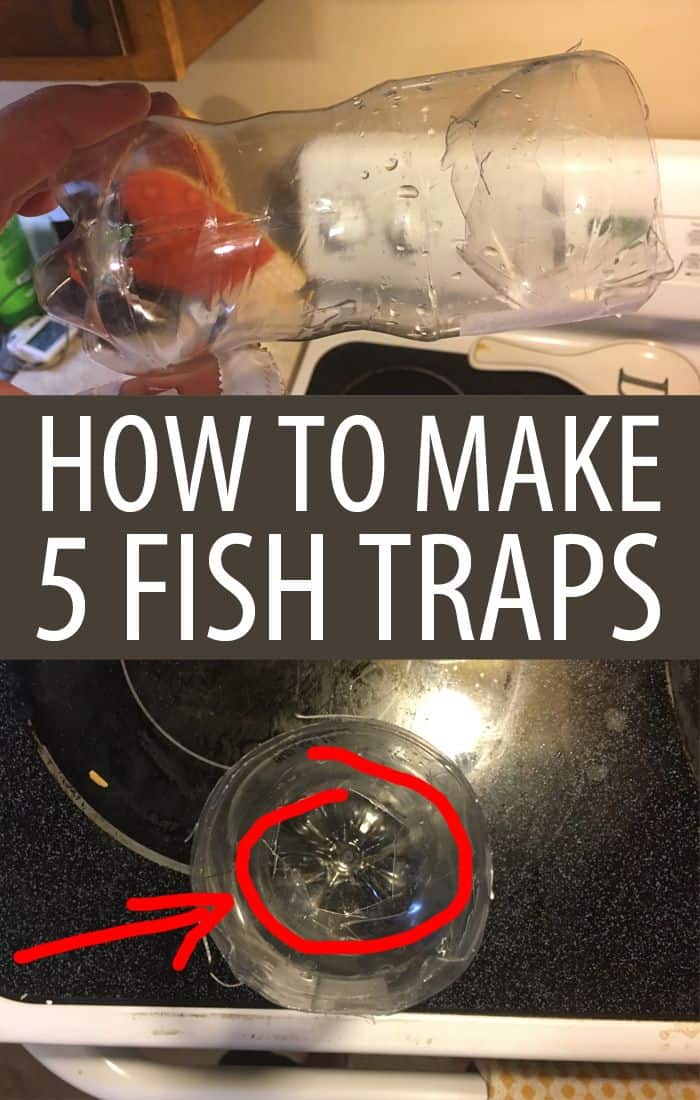

My name is Ryan Dotson and I am a survivalist, prepper, writer, and photographer. I grew up in the Ozark Mountains and in the foothills of the Pocono Mountains. My interest in survival started when I was in Boy Scouts and continued as my father, uncle, and grandfather taught me to hunt and fish. In the last few years I have started taking on survival challenges and have started writing about my experiences. I currently live in Mid-Missouri with my wife Lauren and three year old son Andrew.

Excellent subject! Learning to make fish traps and stitch netting is an interesting hobby and survival skill. I
went to school in the Pacific NW to help design, sew and repair commercial net gear. You tube features great
videos on subject. Like many crafts it is best to learn how well before an emergency need.